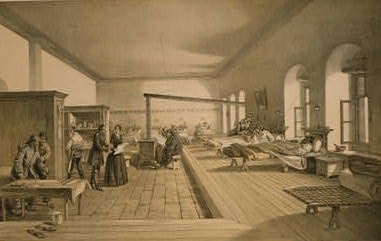by Nathaniel Roy

In the 1800s, the American Board of Missionaries were increasingly interested in the Far East and the Ottoman Empire. During this time period, there was a need for pastors and teachers beyond the elementary level, and, with a high school being built by the Syrian mission, it was agreed that the same needed to be done in the empire’s capitol city, Istanbul.[1] This is why Bebek Seminary was started in Bebek, five miles from Constantinople, and Cyrus Hamlin was placed in charge.
It is important to note that Christians were the minority in the Ottoman Empire, and they mostly came from the Caucasus and the Balkan Peninsula. During the Russian War of 1828 against the Ottoman Empire, Orlando Figes states, “In parts of the southern Caucasus, the Christian Georgians and Armenians sided with the Russian invasion and took a share of the spoils.”[2] The Ottoman Empire had control of this southern section; this section housed Christian Georgians and Armenians who had the sanctions and taxes against them. Christians in the Middle East had been in the minority for some time at this point, and they were subject to persecution and oppression.
As Constantin Alexandrovich Panchenko states in Arab Orthodox Christians Under the Ottomans 1516–1831, that “The real, rather than ideal, state of affairs in the domain of interfaith relations was, according to witnesses, far from the desired harmony. The patriarchs in Istanbul had “’no immunity, no special respect.’ Some were hanged and many were subjected to various punishments and were thrown in prison.’”[3] This same sentiment can be seen in James Grehan’s Article “Imperial Crisis and Muslim-Christian Relations in Ottoman Syria and Palestine, c. 1770-1830,” when he states, “Non-Muslims were subject to laws and regulations that excluded them from the highest ranks of state. They had to pay a poll tax (cizye) and accept certain legal handicaps regarding the value of their testimony in court. They had to abide by symbolic forms of discrimination that required them to wear (or not to wear) certain colors, forbade them to bear arms or ride horses, and placed restrictions on their public worship.”[4] Christians in the Ottoman Empire had to abide by these laws to obtain the religious toleration that they desired. Of course, this toleration came at a cost.
Cyrus Hamlin originally wanted to just help the surrounding peoples and the Christians in the Ottoman Empire. However, little did he know, he would be helping the British army very soon. When he opened his seminary, Hamlin committed to create a workshop for his students.[5] This workshop would help provide money for his students, and, according to Hamlin, “one should be able to earn enough to clothe himself decently.”[6] Eventually, what Hamlin decided to do was to make bread out of his seminary. This workshop would then evolve into something even bigger than even Hamlin could have believed. The Crimean War brought with it hunger and pain, and the bread Hamlin produced took on new value.
Notes
[1] Field, America and the Mediterranean world, 1776-1882, 352.
[2] Orlando Figes, The Crimean War A History, (New York, Henry Holt and Company) 19.
[3] Constantin Alexandrovich Panchenko, Arab Orthodox Christians Under the Ottomans 1516–1831, Jordanville, NY: Holy Trinity Seminary Press, 2016.
[4] James Grehan, “Imperial Crisis and Muslim-Christian Relations in Ottoman Syria and Palestine, c. 1770-1830,” Journal of the Economic & Social History of the Orient 58, no. 4 (December 2015): 494.
[5] Hamlin, My Life and Times, 257.
[6] Hamlin, My Life and Times, 257.